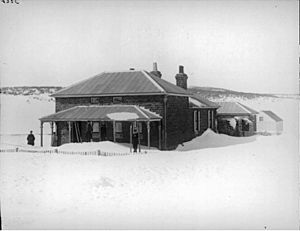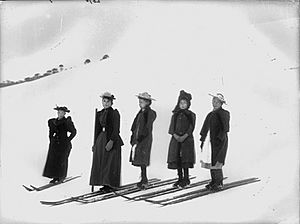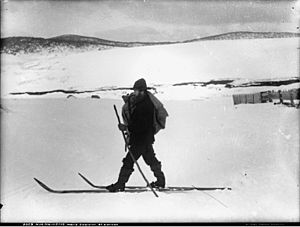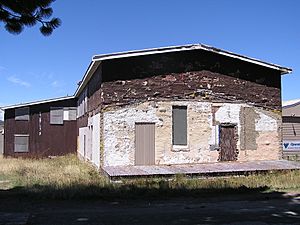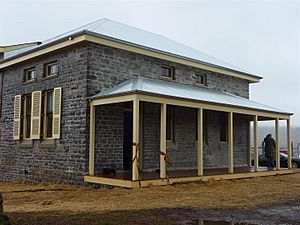Kiandra, New South Wales facts for kids
Quick facts for kids KiandraNew South Wales |
|
|---|---|
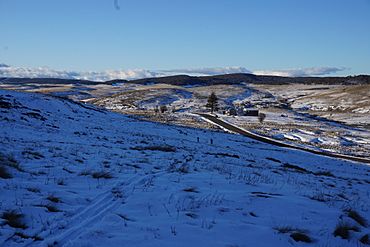
View over Kiandra from a nearby hill
|
|
| Established | 1839 |
| Postcode(s) | 2630 |
| Elevation | 1,400 m (4,593 ft) |
| Location | 90 km (56 mi) NW of Cooma |
| LGA(s) | Snowy Monaro Regional Council |
| State electorate(s) | Monaro |
| Federal Division(s) | Eden-Monaro |
Kiandra is an old gold mining town in the Snowy Mountains of New South Wales, Australia. It's also famous as the place where Australian skiing began!
The town is located inside the Kosciuszko National Park. Its name, Kiandra, comes from an Aboriginal word 'Gianderra', meaning 'sharp stones for knives'. Before that, it was called Gibson's Plains. For about 100 years, Kiandra was the highest town in Australia.
Kiandra is about 90 kilometres (56 mi) north-west of Cooma. It sits high up at 1,400 metres (4,600 ft) above sea level. The town is on a treeless ridge next to the Eucumbene River. In winter, this area is covered in snow and can get very windy.
Over the years, many buildings in Kiandra fell into disrepair. From 2009 to 2020, people worked to fix up the old buildings. This included the historic Kiandra Courthouse Chalet. But sadly, many of the remaining buildings were damaged or destroyed during the big bushfires in 2019–2020.
Contents
Kiandra's Past: Gold and Snow
The Gold Rush Story
In November 1859, some mountain cattlemen, the Pollock brothers, found gold in Kiandra. News spread fast! By March 1860, about 10,000 miners and storekeepers rushed to the area. At first, they found a lot of gold. A huge gold nugget, weighing 9 kilograms, was found in the river.
The Kiandra post office opened on June 1, 1860. At its busiest, the town had around 15,000 people. There were 25 stores, 13 bakers, 16 butchers, 14 pubs, banks, and blacksmiths. But by 1861, the easy gold was gone, and many people started to leave.
Many Chinese miners also worked in the Kiandra goldfields. In 1882, Chinese miners built Three Mile Dam. This dam helped them use water to find gold. Today, this beautiful lake still exists. It provides water for making snow at Selwyn Snowfields.
The last gold mining stopped around 1905. In total, over 48,000 kilograms of gold were officially found here.
The second courthouse in Kiandra was built in 1890. It was also used as a police station until 1937. Later, it became the Kiandra Chalet. You can still see old mining tools, like a 'battery stamper', near Kiandra. This stamper was used to crush rocks to get the gold out.
Skiing: Australia's First Ski Town
Kiandra often gets covered in deep snow during winter. Because of this, it was hard to get in and out. In 1861, some miners from Norway brought skiing to the town. They made over 40 pairs of skis, both short "skates" and longer "snow shoes". These were described as "two palings turned up at the front end and about four foot long".
Ski races were held every year on Township Hill in Kiandra. This led to the creation of the Kiandra Snow Shoe Club. This club is thought to be the "world's longest continuously running ski club". It later became the Kiandra Pioneer Ski Club, now located at Perisher Valley. The famous poet Banjo Paterson was even a vice president of the club!
In 1908, the club held what might have been the first international ski race carnival. In 1927, some club members made the first ski trip from Kiandra to the Hotel Kosciusko. This amazing journey is remembered in a book called "Kiandra to Kosciusko".
The Kiandra courthouse stopped being a police station in 1937. It was then used as a home, and later as the Kiandra Chalet Hotel. The owner of the Chalet even had a ski rope tow. The Chalet closed in 1973.
Australia's first T-bar lift for skiing was put on Township Hill in 1957. But in 1978, Kiandra's ski lifts moved to nearby Selwyn Snowfields. The T-Bar was used at Mount Selwyn until 2009.
Bringing Kiandra Back to Life
The last person living in Kiandra left in 1974. After that, the National Parks and Wildlife Service (NPWS) took over. They removed most of the town's buildings. Only four buildings from the old town are still standing, along with some ruins and a historic cemetery. The area still has other old items from Australia's early history, like mining tools and old graves.
The remaining buildings in Kiandra are very important for history. There are walking trails that tell you about the old town. The biggest building left is the old courthouse, built in 1890. The NPWS partly fixed it up in 2010 to be an information center. The restored courtroom opened on May 5, 2010.
In 2012, people could stay in Kiandra again! The restored Wolgal Lodge, a fishing cottage from the 1960s, opened for bookings. This was done to show that people wanted to stay in Kiandra.
In Easter 2013, all four of Kiandra's buildings were open to the public for the first time in many years. There were guided tours and exhibitions.
The 2020 Bushfire Impact
During the big bushfires of 2019–2020, a fire called the Dunns Road fire reached Kosciuszko National Park on January 3, 2020. It burned a large part of the northern park. The courthouse was badly damaged. The fire was so hot that the glass and aluminum in the windows melted. Wolgal Hut and Pattisons Huts were also thought to be destroyed.
Important Historical Places
The Kosciuszko National Park has several places listed as important historical sites, including:
- Kiandra: Kiandra Courthouse
- Kiandra: Matthews Cottage
Kiandra in Books and Photos
Many books and photos tell the story of Kiandra.
- Historic Kiandra: A Guide to the History of the District by D. G. Moye (editor) was published in 1959. It came out for the 100-year anniversary of the Kiandra Goldrush.
- Klaus Hueneke, who loves the Australian High Country, wrote two books about the Kiandra area: Huts of the High Country (1982) and Kiandra to Kosciusko (1987).
- The Kiandra Pioneer Ski Club also published two history books: Kiandra – Gold Fields to Ski Fields (2006) and Lapland Snow Shoes in Australia (2010).
Poets like Barcroft Boake and Banjo Paterson wrote poems about Kiandra. Patrick White's first novel, Happy Valley (1939), features a town much like Kiandra. The 2011 adventure novel Falling into History by Peter Fleming is also partly set in Kiandra.
Scientists have studied the old town to learn more about its history. The Kiandra Historical Society is a great place to find information about the town. Many interesting photos were taken of life in Kiandra, including some by Charles Kerry.
Kiandra's Weather
Kiandra is high up, so it has a cool climate. It gets very cold and snowy winters. Summers are cool, and it can even snow sometimes in summer! Kiandra gets snow about 47 days each year.
Weather records were kept at the Kiandra Chalet from 1866 to 1974. The coldest temperature ever recorded in Kiandra was −20.6 °C (−5 °F) on August 2, 1929. This was also the lowest temperature recorded in Australia at that time! The highest temperature recorded was 34.7 °C (94.5 °F) in January 1939.
| Climate data for Kiandra Chalet (1897–1974, extremes 1957–1974, rainfall to 1866); 1,395 m AMSL; 35.88° S, 148.50° E | |||||||||||||
|---|---|---|---|---|---|---|---|---|---|---|---|---|---|
| Month | Jan | Feb | Mar | Apr | May | Jun | Jul | Aug | Sep | Oct | Nov | Dec | Year |
| Record high °C (°F) | 32.9 (91.2) |
32.8 (91.0) |
27.2 (81.0) |
22.8 (73.0) |
21.1 (70.0) |
14.4 (57.9) |
10.6 (51.1) |
16.7 (62.1) |
23.3 (73.9) |
23.3 (73.9) |
27.8 (82.0) |
29.5 (85.1) |
32.9 (91.2) |
| Mean daily maximum °C (°F) | 20.7 (69.3) |
20.7 (69.3) |
17.8 (64.0) |
13.1 (55.6) |
8.7 (47.7) |
5.4 (41.7) |
3.9 (39.0) |
5.4 (41.7) |
8.7 (47.7) |
12.6 (54.7) |
16.1 (61.0) |
19.1 (66.4) |
12.7 (54.9) |
| Daily mean °C (°F) | 13.4 (56.1) |
13.3 (55.9) |
10.9 (51.6) |
7.0 (44.6) |
3.5 (38.3) |
1.1 (34.0) |
−0.4 (31.3) |
0.8 (33.4) |
3.6 (38.5) |
6.7 (44.1) |
9.6 (49.3) |
12.0 (53.6) |
6.8 (44.2) |
| Mean daily minimum °C (°F) | 6.1 (43.0) |
6.0 (42.8) |
4.0 (39.2) |
0.9 (33.6) |
−1.7 (28.9) |
−3.2 (26.2) |
−4.7 (23.5) |
−3.8 (25.2) |
−1.4 (29.5) |
0.8 (33.4) |
3.2 (37.8) |
5.0 (41.0) |
0.9 (33.6) |
| Record low °C (°F) | −3.9 (25.0) |
−5.6 (21.9) |
−7.2 (19.0) |
−10.8 (12.6) |
−13.0 (8.6) |
−15.6 (3.9) |
−17.8 (0.0) |
−17.8 (0.0) |
−11.1 (12.0) |
−7.8 (18.0) |
−7.0 (19.4) |
−6.7 (19.9) |
−17.8 (0.0) |
| Average precipitation mm (inches) | 90.3 (3.56) |
71.4 (2.81) |
94.4 (3.72) |
114.0 (4.49) |
146.6 (5.77) |
185.9 (7.32) |
165.0 (6.50) |
164.2 (6.46) |
152.1 (5.99) |
160.6 (6.32) |
116.8 (4.60) |
99.9 (3.93) |
1,561.2 (61.47) |
| Average precipitation days (≥ 0.2 mm) | 7.6 | 6.8 | 7.7 | 9.3 | 11.7 | 14.1 | 13.8 | 14.3 | 12.9 | 12.5 | 10.1 | 8.7 | 129.5 |
| Average afternoon relative humidity (%) | 49 | 51 | 55 | 62 | 69 | 76 | 79 | 73 | 65 | 57 | 54 | 51 | 62 |
| Mean monthly sunshine hours | 288.3 | 251.4 | 241.8 | 195.0 | 142.6 | 114.0 | 111.6 | 124.0 | 156.0 | 213.9 | 240.0 | 282.1 | 2,360.7 |
| Source 1: Bureau of Meteorology | |||||||||||||
| Source 2: Bureau of Meteorology (sunshine hours from Cabramurra SMHEA, 1962−1999) | |||||||||||||



